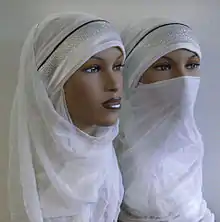Muslim feminist views on hijab
Islamic feminist views on dress codes include views on issues surrounding women's dress codes in Islam, especially on the hijab and niqāb.

Islam requires women to wear a headscarf, also known as the hijab. Hijab traditionally refers to a type of veiling which covers the skin from the hair to the chest. Niqāb refers to a cloth that covers the face as a part of sartorial hijab. There are mixed opinions among Muslim feminists regarding the merits of veiling.
History
The Qur'an states that men and women should be dressed modestly (33:59-60, 24:30-31; in translation by Ali, 1988, 1126–27). However, it does not use the words veil, hijab, burqa, chador, or abaya. Instead, it uses the words jilbab (cloak) and khumur (shawl). These garments do not cover the face, hands, or feet.
Until the third through the ninth centuries (Hijri) women prayed in mosques unveiled.
Views in support of hijab or emphasizing freedom of choice
Many Muslim feminists today see the veil as a symbol of Islamic freedom or otherwise attribute a personalized meaning to it.[2]
Feminists such as Leila Ahmed say the veil no longer represents "a woman's brainwashed submissiveness or at the very least her lack of choice" and note that many American Muslims have worn the hijab to show opposition to anti-Muslim discrimination following the September 11 attacks or to show solidarity with Palestine.[3]
Since 2012, the hijab has become more prominent in countries around the world where state law does not require women to wear the hijab.[2] For some of these women the hijab acts as a statement of pride in Islam, femininity, and sexual identity rather than as a representation of the oppression of women. Feminist philosophers such as Luce Irigaray note that the veil can take on the role of empowerment regarding a woman's sexual difference from man.[2]
Some feminists link the freedom to wear the hijab to women having a right over their own body. Publicist Nadiya Takolia adopted the hijab after becoming a feminist, saying the hijab "is not about protection from men's lusts," but about "telling the world that my femininity is not available for public consumption...and I don't want to be part of a system that reduces and demeans women."[4]
Many modern Muslim feminists believe a woman's freedom of choice is the most important thing and that she should be able to choose whether to wear the veil or not without being coerced or threatened. This view is in accordance with a Muslim feminist's personal expression of Islamic faith, Muslim women should be able to define dress codes for themselves and what they deem to personally empower them.[5]
Views in opposition to hijab
Women in opposition to the hijab claim that whole body covering with the burka, chador, and other items of clothing is a cultural tradition that arose from a conservative reading of the Qur'an by male mullahs, and that the Qur'an itself does not require such covering.[6]
A section of Muslim feminists, including Fadela Amara and Hédi M'henni, do support bans on the hijab due to their view that the hijab inherently represents a subjugation of women. Amara supported France's ban of the garment in public buildings, saying "the veil is the visible symbol of the subjugation of women, and therefore has no place in the mixed, secular spaces of France's public school system."[7] She also pointed to the fact that feminists in Algeria fought against wearing the veil, accusing those who criticized the ban as participating in neocolonialism.[7] Mhenni expressed support for Tunisia's ban on the veil on similar grounds, claiming that acceptance of the veil would lead to acceptance of women's rights being limited.[8]
Sihem Habchi, director of the French feminist movement Ni Putes Ni Soumises, expressed support for France's ban on the burqa in public places, stating that the ban was a matter of "democratic principle" and protecting French women from the "obscurantist, fascist, right-wing movement" that she said the burqa represented.[9][10]
See also
Bibliography
- Hammad, Amber (2021). Hammad, Amber (2021) Unveiling The Veil: Self-Representation in Contemporary Muslim Female Art (Thesis). UNSW Sydney. doi:10.26190/unsworks/2038. hdl:1959.4/100128.
References
- Elrich, Hagai. Al-Ahbash and Wahabi (PDF). Cambridge University. p. 528. Archived (PDF) from the original on 2017-12-15. Retrieved 2018-08-06.
- Berger, Anne-Emmanuelle (1998). "The Newly Veiled Woman: Irigaray, Specularity, and the Islamic Veil". Diacritics. 28 (1): 93–119. doi:10.1353/dia.1998.0001. JSTOR 1566326. S2CID 170559271.
- Moeveni, Azadeh (June 13, 2011). "Is the Veil Now a Symbol of Islamic Freedom?". Time. Archived from the original on 2014-05-03. Retrieved 2014-05-02.
- Takolia, Nadiya (28 May 2012). "The hijab has liberated me from society's expectations of women". The Guardian. Retrieved 1 December 2022.
- "Veiling and Hijab as understood". irfi.org. Archived from the original on 2015-11-15. Retrieved 9 December 2015.
- Asma Barlas (2002). Believing Women in Islam. Austin: University of Texas Press. p. 53-55.
- George, Rose (July 17, 2006). "Ghetto warrior". The Guardian. London. Archived from the original on 2013-08-30. Retrieved May 5, 2010.
- "IslamOnline.net- News". Archived from the original on June 1, 2010. Retrieved August 31, 2009.
- Malik, Zubeida (March 15, 2010). "France's burka dilemma". BBC News. Archived from the original on 2010-08-09. Retrieved 2010-07-15.
- "Ni Putes Ni Soumises Organizes a Protest Against the Burqa - VINGT Paris News". Archived from the original on 2010-05-22. Retrieved 2010-07-15.